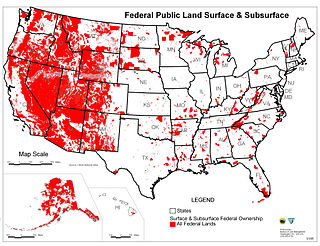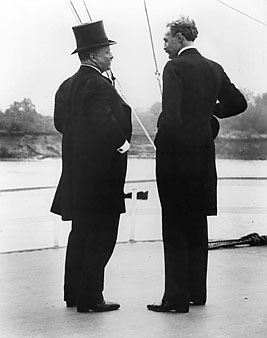
The Religious Freedom Restoration Act of 1993, Pub. L. No. 103-141, 107 Stat. 1488, codified at 42 U.S.C. § 2000bb through 42 U.S.C. § 2000bb-4, is a 1993 United States federal law that "ensures that interests in religious freedom are protected." The bill was introduced by Congressman Chuck Schumer (D–NY) on March 11, 1993. A companion bill was introduced in the Senate by Ted Kennedy (D-MA) the same day. A unanimous U.S. House and a nearly unanimous U.S. Senate—three senators voted against passage—passed the bill, and President Bill Clinton signed it into law.

The General Mining Act of 1872 is a United States federal law that authorizes and governs prospecting and mining for economic minerals, such as gold, platinum, and silver, on federal public lands. This law, approved on May 10, 1872, codified the informal system of acquiring and protecting mining claims on public land, formed by prospectors in California and Nevada from the late 1840s through the 1860s, such as during the California Gold Rush. All citizens of the United States of America 18 years or older have the right under the 1872 mining law to locate a lode or placer (gravel) mining claim on federal lands open to mineral entry. These claims may be located once a discovery of a locatable mineral is made. Locatable minerals include but are not limited to platinum, gold, silver, copper, lead, zinc, uranium and tungsten.
The Nonintercourse Act is the collective name given to six statutes passed by the United States Congress in 1790, 1793, 1796, 1799, 1802, and 1834 to set boundaries of Native American reservations. The various acts were also intended to regulate commerce between settlers and the natives. The most notable provisions of the act regulate the inalienability of aboriginal title in the United States, a continuing source of litigation for almost 200 years. The prohibition on purchases of Indian lands without the approval of the federal government has its origins in the Royal Proclamation of 1763 and the Confederation Congress Proclamation of 1783.

Federal lands are publicly owned lands in the United States managed by the federal government. Pursuant to the Property Clause of the United States Constitution, Congress has the power to retain, buy, sell, and regulate federal lands, such as by limiting cattle grazing on them. These powers have been recognized in a long series of United States Supreme Court decisions.

The Taylor Grazing Act of 1934 is a United States federal law that provides for the regulation of grazing on the public lands to improve rangeland conditions and regulate their use.
The Forest and Rangeland Renewable Resources Planning Act of 1974(RPA) (16 U.S.C. §§ 1600 et seq.) is a United States federal law which authorizes long-range planning by the United States Forest Service to protect, develop, and enhance the productivity and other values of forest resources. RPA requires that a renewable resource assessment and a Forest Service plan be prepared every ten and five years, respectively, to plan and prepare for the future of natural resources. RPA was reorganized, expanded, and otherwise amended by the National Forest Management Act of 1976.

The Federal Noxious Weed Act of 1974 established a federal program to control the spread of noxious weeds. The United States Secretary of Agriculture was given the authority to declare plants "noxious weeds", and limit the interstate spread of such plants without a permit. The Secretary has the authority to inspect, seize, and destroy products, and quarantine areas, if necessary to contain, or limit the spread of such weeds.

The American Indian Religious Freedom Act, Public Law No. 95–341, 92 Stat. 469, codified at 42 U.S.C. § 1996, is a United States federal law, enacted by joint resolution of the Congress in 1978. Prior to the act, many aspects of Native American religions and sacred ceremonies had been prohibited by law.
Title 16 of the United States Code outlines the role of conservation in the United States Code.

In United States law, a federal enclave is a parcel of federal property within a state that is under the "Special Maritime and Territorial Jurisdiction of the United States". While these enclaves, which are used for all the many Federal governmental purposes, such as post offices, arsenals, dams; road; etc., usually are owned by the Government, the United States in many cases has received similar jurisdictional authority over privately owned properties which it leases, or privately owned and occupied properties which are located within the exterior boundaries of a large area as to which a State has ceded jurisdiction to the United States.
Kleppe v. New Mexico, 426 U.S. 529 (1976), was a United States Supreme Court decision that unanimously held the Wild and Free-Roaming Horses and Burros Act of 1971, passed in 1971 by the United States Congress to protect these animals from "capture, branding, harassment, or death", to be a constitutional exercise of congressional power. In February 1974, the New Mexico Livestock Board rounded up and sold 19 unbranded burros from Bureau of Land Management (BLM) land. When the BLM demanded the animals' return, the state filed suit claiming that the Wild Free-Roaming Horses and Burros Act was unconstitutional, claiming the federal government did not have the power to control animals in federal lands unless they were items in interstate commerce or causing damage to the public lands.
The Cooperative Funds Act is a United States law, or series of laws, which authorized the United States Forest Service (FS) to collect donations from private partners to perform FS work. Contributions had to be voluntary, and by cash, check, or money order only. It was also stipulated that there could be no conflict of interest between the donor and the FS.

Starting in 1876, and undergoing a series of name changes, the United States Forest Service grew to protect and use millions of acres of forest on public land. Gifford Pinchot, an early advocate of scientific forestry, along with President Theodore Roosevelt and conservation organizations, led the effort to manage forest for the public good.

The Consolidated Natural Resources Act of 2008 was an act passed in the 110th United States Congress and enacted on May 8, 2008.

The Submerged Lands Act of 1953 is a U.S. federal law that recognized the title of the states to submerged navigable lands within their boundaries at the time they entered the Union. They include navigable waterways, such as rivers, as well as marine waters within the state's boundaries, generally three geographical miles from the coastline.
The Archaeological Resources Protection Act of 1979, also referred to as ARPA, is a federal law of the United States passed in 1979 and amended in 1988. It governs the excavation of archaeological sites on federal and Native American lands in the United States, and the removal and disposition of archaeological collections from those sites.

The Investor Protections and Improvements to the Regulation of Securities is a United States Act of Congress, which forms Title IX, sections 901 to 991 of the much broader and larger Dodd-Frank Wall Street Reform and Consumer Protection Act of 2010. Its main purpose is to revise the powers and structure of the Securities and Exchange Commission, credit rating organizations, and the relationships between customers and broker-dealers or investment advisers. This title calls for various studies and reports from the SEC and Government Accountability Office (GAO). This title contains nine subtitles.
Aboriginal land title in New Mexico is unique among aboriginal title in the United States. Congressional legislation was passed to define such title after the United States acquired this territory following war with Mexico (1846–1848). But the Supreme Court of the New Mexico Territory and the United States Supreme Court held that the Nonintercourse Act did not restrict the alienability of Pueblo lands.

An Organic Act is a generic name for a statute used by the United States Congress to describe a territory, in anticipation of being admitted to the Union as a state. Because of Oklahoma's unique history an explanation of the Oklahoma Organic Act needs a historic perspective. In general, the Oklahoma Organic Act may be viewed as one of a series of legislative acts, from the time of Reconstruction, enacted by Congress in preparation for the creation of a united State of Oklahoma. The Organic Act created Oklahoma Territory, and Indian Territory that were Organized incorporated territories of the United States out of the old "unorganized" Indian Territory. The Oklahoma Organic Act was one of several acts whose intent was the assimilation of the tribes in Oklahoma and Indian Territories through the elimination of tribes' communal ownership of property.

New Mexico Wilderness Act of 1980, Public Law 96-550, is a U.S. federal law that authorized the establishment of a number of designated Wilderness Areas on National Forest land in New Mexico. The law also added additional lands to four existing Wilderness Areas in New Mexico, and named several Forest areas for study as potential Wilderness Areas. The law also created two new National Park Service units, Chaco Culture National Historical Park and Salinas National Monument, from existing NPS lands. By means of this law approximately 400,000 acres of forest land were designated as Wilderness Areas, as described by the Wilderness Act of 1964, and approximately 75,000 additional acres were designated as Wilderness Study Areas for possible future inclusion in the Wilderness program.




